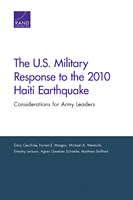| 来源类型 | Research Reports
|
| 规范类型 | 报告
|
| ISBN | 9780833080752
|
| 来源ID | RR-304-A
|
| The U.S. Military Response to the 2010 Haiti Earthquake: Considerations for Army Leaders |
| Gary Cecchine; Forrest E. Morgan; Michael A. Wermuth; Timothy Jackson; Agnes Gereben Schaefer; Matthew Stafford
|
| 发表日期 | 2013
|
| 出版年 | 2013
|
| 页码 | 112
|
| 语种 | 英语
|
| 结论 |
Luck, Serendipity, and Longtime Relationships Fostered Success in Haiti Relief Efforts, Though Actual Performance Is Impossible to Measure Because Metrics and Plans Were Not in Place Before the Earthquake Hit- U.S. Department of Defense policy on humanitarian assistance and disaster relief needs to be updated.
- The Joint Task Force-Haiti commander's informal approach to determining initial requirements and his liberal use of oral orders had people and resources assigned quickly, and U.S. military leaders had significant latitude to exercise initiative in directing response efforts.
- U.S. Southern Command lacked well-established plans for such a mission. The informal, top-down process that pushed resources to the effort quickly generated inefficiencies that might have impaired the operation's effectiveness, but a lack of established metrics prevented measuring performance.
- Specific circumstances may have worked to the advantage of Joint Task Force-Haiti (JTF-Haiti): U.S. Southern Command military deputy commander, LTG P. K. Keen, was in Haiti and at the U.S. ambassador's residence when the earthquake struck; the ambassador's residence withstood the earthquake, and the communication equipment there remained functional; General Keen was a longtime colleague of the UN Stabilization Mission in Haiti commander; the Global Response Force was available for rapid deployment to JTF-Haiti; the JTF-Haiti commander had a positive professional relationship with the XVIII Airborne Corps commander; and many service members assigned to JTF-Haiti had a high level of experience in civil affairs and other aspects of working with local citizens.
|
| 摘要 |
- Update the U.S. Department of Defense (DoD) directive for foreign humanitarian assistance and disaster relief (HA/DR) to better describe the statutory and organizational changes that have taken place since its last publication and provide important policy guidance to DoD entities and their partners.
- Create a national framework for foreign humanitarian assistance and disaster relief. A national framework for U.S. foreign HA/DR could document and guide a whole-of-government approach for U.S. efforts and facilitate related planning, training, and exercises.
- Ensure that all senior Army commanders are familiar with the guidance provided in the recently published Department of Defense Support to Foreign Disaster Relief (Handbook for JTF Commanders and Below). It should be required reading at U.S. Army intermediate and senior service schools.
- Consider a standing organization to help develop HA/DR doctrine; facilitate HA/DR planning, training, and exercises; establish HA/DR metrics; monitor preparedness and availability of specialized HA/DR units and personnel; provide a base for HA/DR expertise; assist with interagency, intergovernmental, and nongovernmental collaboration; conduct initial assessments of HA/DR requirements; and maintain historical data on HA/DR operations.
|
| 主题 | Disaster Recovery Operations
; Earthquakes
; Emergency Preparedness
; Haiti
; International Humanitarian Assistance
; Military Mobilization
; United States Army
|
| URL | https://www.rand.org/pubs/research_reports/RR304.html
|
| 来源智库 | RAND Corporation (United States)
|
| 资源类型 | 智库出版物
|
| 条目标识符 | http://119.78.100.153/handle/2XGU8XDN/107541
|
推荐引用方式
GB/T 7714 |
Gary Cecchine,Forrest E. Morgan,Michael A. Wermuth,et al. The U.S. Military Response to the 2010 Haiti Earthquake: Considerations for Army Leaders. 2013.
|
|
文件名:
|
1404737808893.gif
|
|
格式:
|
GIF
|

|
文件名:
|
RAND_RR304.pdf
|
|
格式:
|
Adobe PDF
|
除非特别说明,本系统中所有内容都受版权保护,并保留所有权利。